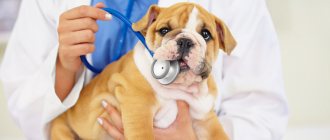With the help of vision, four-legged pets explore and learn about the world. However, this important organ is poorly protected and is therefore often injured. An eye injury in a dog is a dangerous phenomenon that can provoke partial or complete loss of visual function. The article will discuss in detail the causes of eye injuries, their symptoms and treatment methods.
Content
1. The main signs of eye injuries in dogs 2. How eye injuries appear in dogs 3. Classification of eye injuries in dogs 4. First aid instructions 5. Instead of a conclusion
Four-legged pets often damage the organs of vision. This happens due to their own carelessness, difficult walking conditions, or during a clash with relatives. The eyeball of all mammals has approximately the same structure, and therefore delay necessarily leads to complete or partial blindness. This cannot be allowed to happen because a dog with special needs will require extremely complex care. The owner is required to prevent infection, as well as eliminate traumatic consequences in a veterinary clinic as soon as possible.
Symptoms
Mechanical damage to the visual organ is characterized by the sudden onset of symptoms. At the same time, the pet’s eyelids swell, the eye itself turns red, the animal becomes restless and constantly tries to wipe the damaged area with its paws. Sometimes the owner may notice blood stains in the injured area. The easiest way to detect damage is if a foreign object, such as a blade of grass or a small midge, gets into your pet's eye.
The severity of the injury can be checked using an ordinary flashlight. It is enough to direct a beam of light into the damaged eye and see if the pupil has dilated. If there is no reaction, then the injury is very serious, and the animal must be urgently taken to a doctor for examination. With such signs, when the eyeball becomes dark or protrudes beyond the orbit, we can say with confidence that pathogenic microflora has entered the tissue. An animal with such symptoms requires prompt and qualified treatment.
Corneal injury is a very serious pathology that can lead to blindness in a dog. The main signs of such damage are that the dog constantly squints his eyes. He may experience uncontrollable spasms of the eyelids and photophobia. Under no circumstances should you let your pet scratch the damaged area. Against the background of injury, keratitis can develop, an inflammation that leads to clouding of the cornea.
Main signs of eye injuries in dogs
Some of these behaviors may not attract the attention of an inexperienced owner:
- The animal squints or there are convulsive movements of the eyelid. This indicates a foreign body.
- The eye does not open. This is usually the result of a severe blow or swelling due to infection.
- If the animal constantly rubs this place with its paw or on any suitable object, then you need to go to the veterinarian.
- Constantly flowing tears, accompanied by a runny nose due to fluid entering the nasal passages.
- Constant and rapid blinking is an attempt to free yourself from the foreign body.
- If the eyelashes stick together from yellow or green pus, and sticky streaks are visible on the fur.
- The eyeball (white field) is very red, completely red or covered with a network of blood vessels.
- Cloudy spots on the iris and thickening of the upper transparent layer.
Follow us
Find out more about your animal's personality on our social networks
- The pet tries in every possible way to avoid bright light, constantly being in the shade.
- If the pupil does not respond to changes in lighting, it has an unnaturally narrowed or dilated shape that does not change due to the appearance of the stimulus.
- Violation of the symmetry of gaze along the nasal line, lack of movement of one of the eyeballs when an object attracting attention appears. The animal simply moves its head, but cannot turn its eyes.
- Severe swelling, the apple is on the rollout or, on the contrary, sunk deeper than it should be in a normal state.
- With severe injuries, even visible bleeding is possible, but more often it indicates damage to the mucous membrane of the eyelid.
There is no specialized ophthalmologist for animals; this is usually done by general veterinarians. It is not worth carrying out an examination at home, because it will not be possible to make a correct diagnosis and prescribe treatment on your own. Try to hurry to the clinic, if only because the animal may experience excruciating pain that reduces appetite and deprives sleep.
A street cat scratched a dog's eye during a fight.
What should you do in this case? At home, you can prepare an infusion of chamomile or calendula and gently rinse the injured eye with it. To prevent infection of the second healthy eye, it is recommended to rinse it with a fresh swab dipped in chamomile infusion.
If a dirty cat's claw has slightly scratched your eye, your veterinarian will prescribe an antiseptic wash lotion and eye drops to relieve irritation and inflammation. The course of treatment is individual, as it depends on various factors. The animal is under the supervision of a veterinarian for 1-2 weeks. In case of suppuration, experts recommend treating with antibiotic therapy.
How do eye injuries occur in dogs?
Damage is difficult to classify, but usually it is a rough mechanical impact. Quarrels with relatives, clashes with cats or other animals. Birds protecting chicks can also cause serious injury. In a game of chance, dogs do not notice how their eyes fly into branches of bushes, hard grass, wire and other obstacles. This happens especially often in nature. Strong winds easily carry all sorts of debris under the eyelids, and various insects can get there. The owner must prohibit the animal from sticking its head out of the window of a car moving at high speed.
Chemical aggressive substances sprayed nearby also get into the eyes. It could be bad people with a spray can, pesticides in the country. Household tools and fishing gear pose a great danger. Anything that shoots, from fireworks to embers thrown from burning wood. Most cases occur due to the carelessness of the owner.
Conventionally, eye injuries in dogs can be divided into mild, moderate and severe types. The latter type almost always leads to complete or partial loss of vision.
Causes
There are a number of predisposing factors that can cause a dog to suffer eye injuries.
Among them:
- Chasing cats through thickets of grass and bushes. There are branches sticking out strongly, which pose a huge danger to the organs of vision;
- Explosions of firecrackers. This is especially true during the New Year holidays. In addition to the fact that many dogs are frightened by loud, sharp noises, fireworks can get into the eye. This often leads to the pet's blindness;
- While hunting or serving. While performing service work, dogs often have to deal with sand, dry leaves, grass and branches. This carries increased risk and the possibility of injury increases. This especially applies to animal ages. Wounds and scratches regularly appear on them;
- Activity, youth and neurosis. Pets that are too nervous or easily excitable often injure their own eyes by fighting with other animals or playing with them. These factors should be taken seriously. If you have the slightest suspicion of injury, you should immediately contact your veterinarian.
Damage to the eyelids
They are divided into end-to-end and non-through. A piece of the eyelid may come off. The most effective treatment for injuries to this part of the eye can only be achieved by contacting a veterinarian on the first day after receiving the injury. If you cannot show your pet to a specialist within 2 hours, then you must immediately wash the wound. To do this you will need a solution of furatsilin 1:5000. It is safe for the animal and will not cause any negative effects if it accidentally gets into the eye.
In case of heavy bleeding, it is recommended to apply a napkin to the damaged area. It must be sterile. Carefully bandage the injury site.
Classification of eye injuries in dogs
These damages can be roughly divided into the following types:
| Injuries | Injured cornea. This is usually a cut, scrape or minor puncture. Occurs upon contact with sharp, hard, stationary objects or when exposed to fragments. Some animals create trouble for themselves by scratching their faces with their paws. |
| Ulcers | Ulcerative manifestations on the cornea and eyelid. A dog may scratch its own eye for whatever reason. Also, constantly rubbing the eye with a speck or hair leads to thinning of the surface layer of the apple. This may also be a manifestation of a congenital corneal defect. |
| Wounds | A puncture wound is the most dangerous. If the puncture area is small, then the situation can be corrected. If intraocular pressure is lost and internal fluid leaks out, everything will end in amputation in the clinic. |
| Gap of the century | A tear in the eyelid appears as part of complex injuries in a collision with hard objects, in a fight with relatives, or in an accident. |
| Prolapse from the eye socket | Small, flat-faced breeds are most susceptible to this. |
| Burns | Thermal burns of the eyelid and eyeball. If structural changes have occurred, then only surgical intervention will help. It may also be needed to eliminate contracture scars that obscure vision. |
Types of injuries
The cornea, sclera and eyelid are the most dangerous and vulnerable to injury areas of your furry friend’s eye. Moreover, the trauma of the first two of them often leads the pet to blindness. Wounds that occur when a foreign body enters the eye are usually divided into the following types:
- Non-penetrating. In this case, the wound channel affects the surface of the cornea, but does not involve deeper layers;
- Penetrating. A dangerous, deep type of damage that can lead to loss of the eye.
In addition, veterinarians divide wounds into simple and complex, with complications and without complications. Surgical intervention is required for complicated wounds, when the injury has led to extensive damage to the cornea and sclera. Surgery for severe mechanical damage is also necessary to remove the remains of the eye.
Wounds that reach the choroid of the eyeball are especially dangerous. Such an injury makes the visual organ vulnerable to harmful infection, which can lead to uveitis (an inflammatory process in the choroid). A bruise that damages the lens is the most serious injury of all; because of it, the animal will most likely become one-eyed.
It is important to understand that even the slightest injury to the eye apparatus can lead to blindness. This is due to the localization of the site of inflammation if it occurs, that is, in the immediate vicinity of the pet’s brain. In addition, any pathology of the eye increases the risk that the dog will eventually develop glaucoma or have increased intraocular pressure. All this inevitably leads to a decrease in visual acuity.
First aid instructions
The owner must independently determine whether to look for signs of eye injury in dogs and then follow these instructions:
- Any folk recipes are strictly prohibited. A person can describe sensations or analyze a situation. You may be giving your dog something that will make the situation worse.
- The first measure taken is to rinse the eye with boiled, cooled water and apply a small cold compress.
- An assistant may be required to avoid touching the eye itself, but to open the eyelids. It is advisable that it be someone familiar to the dog, so that a bite does not occur.
- Hypertonic saline solution, sold in pharmacies, is also good for rinsing. To do this, place the dog on a table with good lighting.
- The head can be fixed by wrapping it in a dry towel. But you can't do this on the neck. Keep your eye open, and then direct a stream of water there from a syringe or syringe without a needle.
- Wait 1 hour to see improvement. If they do not occur, then immediately pick up the pet and take it to the veterinary clinic.
The doctor will independently decide on treatment, remove foreign bodies, and prescribe medications. The dosage regimen must be strictly observed, as well as preventive examinations. After surgery, a course of antibiotics may be prescribed to prevent infection. It is mandatory to wear a plastic conical collar for the period prescribed by the veterinarian.
What will the doctor do at the appointment?
A complete ophthalmological examination will be performed, which includes:
- biomicroscopy of the eye (examination under magnification);
- ophthalmoscopy (examination of the retina and optic nerve head for post-traumatic damage);
- assessment of pupil reactions to light;
- An ultrasound of the eyeball is done when there is severe swelling of the cornea and it is impossible to examine the internal structures of the eye;
- fluorescein test (staining the cornea with a safe dye) - if necessary.
The test allows you to evaluate several positions at once: the area and depth of damage, the retention time of the tear film. Thanks to this, one can judge the presence or absence of dry eye syndrome and the patency of the nasolacrimal duct.
Photo
In the photo you can clearly see what the eye looks like when the blood vessels in it have burst. Given in varying degrees:











